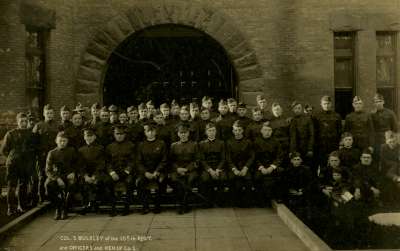
Circa. 1919. Photo of Company L, 105th Regiment, photo taken in front of what is now our Military Museum in Saratoga Springs, NY.
The 105th Infantry Regiment, formerly the 2nd New York Infantry was a New York State National Guard Regiment that saw action in a number of conflicts, including the Civil War, the Spanish-America War, the Mexican Border dispute of 1916, World War I, and finally World War II. For service in WWI, the 2nd New York Infantry officially became the 105th Infantry and was strengthened considerably by troops from the 71st Regiment. It was paired with the 106th infantry Regiment and attached to the 53rd Brigade of the 27th Division. The unit had at the commencement of the active fighting a total effective strength of 2,720 officers and men. The 105th shipped out to Europe in May of 1918, and upon arrival was stationed with the rest of the 27th division along a section of the East Poperinghe Line, which was the allied third line of defense in the Dickbeusch Lake/Scherpenberg Sector.
On July 25th 1918 the 27th division was slowly rotated into the front line in relief of the British 6th Division. German offensives during late March and late April of 1918 had driven deep salients into the allied lines near Amiens and Hazebrouck. On August 31st 1918, operations of the Ypres-Lys Offensive began in an attempt to remove the Germans from the Dickebusch/Scherpenberg area, and thus reduce the Amiens salient. This would free the Amiens-Paris railroad and safeguard allied communications. The responsibility for the assault on the 31st fell to the 53rd Brigade with the 105th regiment attacking on the left, abreast of the 106th Regiment. Over the next couple of days the 105th Regiment advanced against moderate German resistance until the entire 27th Division was relieved by the British 41st Division. The 27th Division was transferred to the British 3rd Army on September 4th and was stationed near Doullens in a reserve position. By mid-September, the German salients had been reduced and the allied armies were finally in a position to launch their own offensive. The Somme offensive was organized and launched from September 24th 1918 to October 21st 1918 with the express purpose of piercing the Hindenburg line, a complex system of German defenses with an average depth of six to eight kilometers. On September 27th, elements of the 105th moved forward in support of an attack by the 106th Regiment. Modest gains were made, initially near Quennemont Ferme, Guillemont Ferme, and a fortified hill creatively labeled “The Knoll”, but German counterattacks threw the two regiments back on their starting place. On the 29th of September, the 105th, which had been sent to the rear as a reserve advanced on the Knoll, but was checked by savage amounts of machine gun fire that rained down from the elevated German positions. On October 1st, the whole of the 27th Division was moved again, this time to Premont where it would serve with the American 2nd corp. On October 17th the 105th helped spearhead an assault against the German defenses, and rapidly took a portion of the line at L’Arbe de Guise, holding it against vigorous counterattacks. The following day, the 105th attacked again, advancing to one of the main north-south German lines, which ran through Jonc de Mer Ferme before being halted by strong resistance. On October 19th the 105th advanced from their forward positions in the face of slight opposition, and easily took the main German works. The Germans placed in an untenable position by the 105th the previous day had been forced to withdraw. The 105th Regiment held the line until October 21st when the entire division was relieved. By March 19th 1919 the 105th had returned in full to the states where it was quickly mustered out.
During its service in World War I, the 105th sustained 1,609 casualties including 1,284 wounded, 253 killed, and 72 who later died of their wounds.





